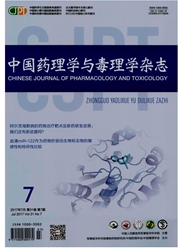

 中文摘要:
中文摘要:
目的 评价海马神经元腺苷A1受体在异氟醚麻醉诱发老龄小鼠认知功能障碍中的作用.方法 腺苷A1受体基因敲除纯合子小鼠(基因敲除小鼠)和野生型小鼠各16只,雄性,18~ 22月龄,体重27~ 32 g,采用随机数字表法,将两种小鼠各分为2组(n=8):对照组(C组)和异氟醚麻醉组(Ⅰ组).Ⅰ组吸入1.4%异氟醚2h,载气为纯氧,C组仅吸入纯氧.麻醉后24 h进行Morris水迷宫实验,随后处死小鼠,采用免疫组化法测定海马组织β淀粉样蛋白1-42(Aβ1-42)斑块数量,采用Western blot法检测磷酸化tau(p-tau)蛋白和含2B亚基的NMDA受体(NR2B)的表达水平.结果 与野生型小鼠的C组比较,野生型小鼠的Ⅰ组逃避潜伏期延长,海马组织Aβ1-42斑块数量增加,p-tau蛋白表达上调,NR2B表达下调(P<0.05);与野生型小鼠的Ⅰ组比较,基因敲除小鼠的Ⅰ组逃避潜伏期缩短,海马组织Aβ1-42斑块数量减少,p-tau蛋白表达下调,NR2B表达上调(P<0.05);基因敲除小鼠的Ⅰ组和C组上述指标差异无统计学意义(P>0.05).结论 海马神经元腺苷A1受体介导异氟醚麻醉诱发老龄小鼠认知功能障碍,其机制与促进Aβ沉积、tau蛋白磷酸化及抑制NR2B活性有关.
 英文摘要:
英文摘要:
Objective To evaluate the role of adenosine A1 receptors in hippocampal neurons in the cognitive dysfunction caused by isoflurane anesthesia in aged mice.Methods Sixteen male adenosine A1 receptor gene knockout homozygote mice (gene knockout mice) and 16 male wild-type mice,aged 18-22 months,weighing 27-32 g,were studied.Each type of mice was randomly divided into 2 groups (n=8 each) using a random number table:control group (group C) and isoflurane anesthesia group (group Ⅰ).Mice inhaled 1.4% isoflurane in 100% O2 for 2 h in group Ⅰ,and 100% O2 for 2 h in group C.All the mice underwent Morris water maze test at 24 h after isoflurane or O2 inhalation.After the test,the mice were sacrificed and the hippocampal tissues were harvested to determine the number of β-amyloid1-42 (Aβ1-42) plaques (using immunohistochemistry) and expression of phosphorylated tau (p-tau) protein,and 2B subunit-containing N-methyl-D-aspartate receptors (NR2B) (by Western blot analysis).Results Compared with group C of wild type mice,the escape latency was significantly prolonged,the number of Aβ1-42 plaques was enlarged,the expression of p-tau protein was up-regulated,and the expression of N R2B was down-regulated in group Ⅰ of wild type mice.Compared with group Ⅰ of wild type mice,the escape latency was significantly shortened,the number of Aβ1-42 plaques was decreased,the expression of p-tau protein was down-regulated,and the expression of NR2B was up-regulated in group Ⅰ of gene knockout mice.There was no significant difference in the parameters mentioned above between group Ⅰ and group C of gene knockout mice.Conclusion Adenosine A1 receptors in hippocampal neurons mediate isoflurane anesthesia-induced cognitive dysfunction in aged mice,and the mechanism may be related to promotion of deposition of Aβ,phosphorylation of tau protein and inhibition of activities of NR2B.
 同期刊论文项目
同期刊论文项目
 同项目期刊论文
同项目期刊论文
 期刊信息
期刊信息
